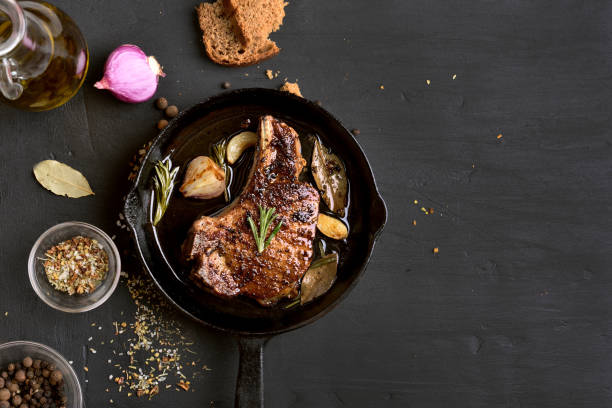When the weather outside is less than ideal for grilling, or if you simply prefer the convenience of cooking indoors, mastering the art of pan-searing and oven-finishing your steak is a valuable culinary skill. This method ensures your steak turns out beautifully seared on the outside and perfectly cooked on the inside, with flavors that rival any outdoor grill.
The Steak Selection
The first step to indoor steak perfection is choosing the right cut of meat. While your personal preference plays a significant role, some cuts are better suited for pan-searing and oven-finishing due to their tenderness and thickness. Here are a few excellent options:
- Ribeye: Known for its marbling, a ribeye steak is a prime choice for indoor cooking. The intramuscular fat ensures a juicy and flavorful result.
- New York Strip: This well-marbled cut offers a balanced combination of tenderness and beefy flavor, making it a favorite for indoor cooking.
- Filet Mignon: If you’re seeking the most tender steak, the filet mignon is your top pick. Its leanness allows the flavor to shine through, and it responds well to pan-searing and oven-finishing.
- Sirloin: A sirloin steak is a budget-friendly option that still delivers excellent results when prepared using this method.
Preparing the Steak
- Bring to Room Temperature: Take the steak out of the refrigerator at least 30 minutes before cooking. Allowing it to reach room temperature ensures even cooking.
- Season Generously: Season the steak with salt and pepper on both sides. For extra flavor, consider adding herbs, garlic, or spices to create a custom seasoning blend.
The Pan-Searing Process
- Select the Right Pan: A heavy-bottomed, oven-safe skillet (such as cast iron) is ideal for pan-searing. The skillet should be large enough to comfortably hold the steak without overcrowding.
- Preheat the Pan: Place the skillet over medium-high heat and allow it to become hot but not smoking. Add a high smoke point oil like vegetable oil or grapeseed oil.
- Sear the Steak: Gently lay the steak in the hot skillet and avoid moving it. Let it sear undisturbed for a few minutes until a golden crust forms on the bottom.
- Flip and Sear: Use tongs to flip the steak and sear the other side. Depending on your preferred level of doneness, adjust the searing time accordingly. A meat thermometer can be helpful.
- Add Aromatics (Optional): During the last minute of searing, add aromatics like garlic, thyme, and a knob of butter to the skillet. Baste the steak with the melted butter for added flavor.
Transition to the Oven
- Preheat the Oven: While you’re searing the steak, preheat your oven to 400°F (200°C).
- Place the Skillet in the Oven: Once the steak is seared to your liking, transfer the entire skillet to the preheated oven. This step ensures even cooking throughout the steak.
- Roast to Perfection: Allow the steak to roast in the oven until it reaches your desired level of doneness. Use a meat thermometer to achieve precise results. For example, 125°F (52°C) for rare, 135°F (57°C) for medium-rare, and so on.
- Rest the Steak: After removing the skillet from the oven, transfer the steak to a cutting board and let it rest for a few minutes. Resting allows the juices to redistribute within the meat, ensuring a juicy result.
Serving and Enjoying
- Slicing and Presentation: To serve, slice the steak against the grain for the best texture. Drizzle any residual pan juices or a sauce of your choice over the slices.
- Pairing: Choose your favorite side dishes to complement the steak. Classic options include mashed potatoes, sautéed vegetables, or a simple green salad.
Variations and Customizations
While the basic method outlined above delivers outstanding results, you can add personal touches to create unique flavors:
- Compound Butter: Top the cooked steak with a pat of compound butter—flavored butter with herbs, garlic, or spices—for an extra layer of richness.
- Red Wine Reduction: Create a simple red wine reduction by deglazing the pan with red wine, then reducing it to a thick sauce. Drizzle this sauce over the steak.
- Mushroom Duxelles: Spread a layer of mushroom duxelles—a mixture of finely chopped mushrooms, shallots, and herbs—on the seared steak before transferring it to the oven.
- Blue Cheese Crust: For a bold twist, spread a mixture of blue cheese and breadcrumbs on top of the steak before roasting. The result is a savory crust that pairs beautifully with the steak.
Troubleshooting Tips
- Overcooking: To avoid overcooking, rely on a meat thermometer to ensure the steak reaches the desired internal temperature. Remember that the steak will continue to cook while resting.
- Uneven Searing: Ensure the steak’s surface is thoroughly dry before searing to achieve an even crust. Pat it dry with paper towels if needed.
- Oven Temperature: Maintain the recommended oven temperature to prevent overcooking or undercooking.
- Resting: Do not skip the resting step, as it’s crucial for achieving a juicy, evenly cooked steak.
With a few high-quality ingredients, some culinary skills, and a touch of creativity, you’ll be well on your way to savoring perfectly cooked steak year-round, regardless of the weather outside. So, don your apron, preheat your skillet, and get ready to create a steakhouse experience right in your kitchen.
